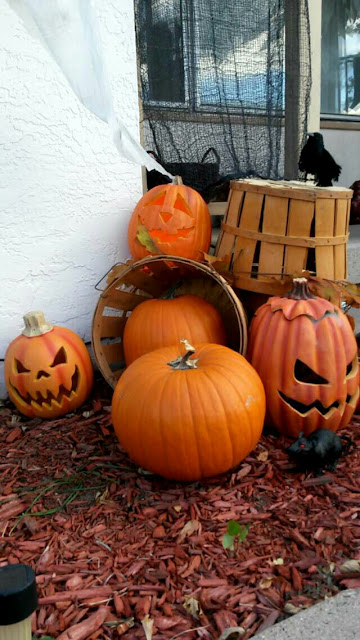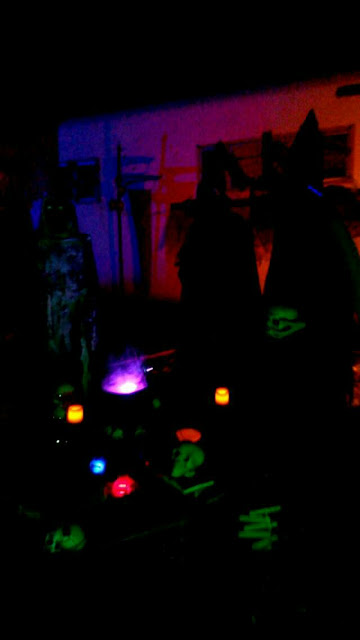$10 - $15 (based on 2018 prices)
Makes three talismans
For the witch den, which was part of my office’s annual decorating competition, I unified the theme by incorporating alchemy symbols into many of the props. These skull talismans were part of this endeavor. Although I selected moderately sized sticks due to the height of the office’s ceiling, you could craft an impressive outdoor display by using larger pieces or constructing one massive stick bundle and adhering multiple masks in various spots.
- Three plastic skull masks
- One yard of white fabric
- At least four tablespoons of dark roasted coffee grounds
- One pan large enough to soak the fabric
- One 4 oz. bottle of all-purpose tacky glue*
- One 2 oz. bottle of acrylic paint in flat black*
- One 2 oz. bottle of acrylic paint in cherry cobbler*
- Nine gnarled sticks
- Hot glue gun and glue sticks
1. Cut the mandibles off of the skull masks. For visual interest, you can create jagged edges; however, I elected for cleaner lines. To make this process easier, purchase masks made from thin plastic. If it helps, trace the outline of your cuts with a marker first.
2. Boil enough water to completely submerge the fabric and pour it into the pan. Add the coffee. The longer you allow the coffee to brew, the darker the stain will become. Likewise, greater amounts of coffee will produce a richer stain. Submerge the cloth in the coffee mixture and soak it until it reaches the color you desire. I soaked mine for four days and scattered the coffee grounds over the top of the fabric to add spots. Remove the fabric from the water and allow it to dry.
3. Cut the fabric into three evenly sized portions large enough to cover the masks and, starting at the front of the skulls, glue cloth to the masks. I found that this process works best if you move in stages: apply a layer of glue to one section, hold the fabric down until it sticks, and then repeat the process.
4. Once the glue has dried, trim the excess fabric from the edges to give the props a cleaner appearance. Alternatively, you could leave the extra cloth, fraying an tattering it for a more unkempt look.
5. Smudge black paint around the eyes and nose and along the edges of the masks to give them a smoky appearance. You may want to experiment with a scrap of leftover cloth before applying the paint to the fabric.
6. Draw alchemy symbols onto the foreheads with red paint. You can add the markings randomly or put them in strategic places. While I elected to use alchemy symbols to unify the haunt’s theme, you could modify the prop by writing spells across the surfaces or using patterns of your own design.
7. Gather about nine sticks (three for each mask). A simple ten-minute walk in the park or woods yields the best and cheapest results. Try to select pieces in varying sizes and shapes. Arrange the sticks in an interesting pattern and hot glue them together. For added support, you could lash them together with steel wire. Additionally, protect your hands during assembly by wearing heavy work gloves.
8. Center the masks on the stick bundles and glue them in place. Although hot glue provided a firm hold, you are free to use superglue or another industrial adhesive to provide a sturdier bond. Once this is done, repurpose the masks’ elastic bands to create hanging loops or, for a more rustic look, use rope or twine.
*You will not use the entire bottle’s content for this project.




















































